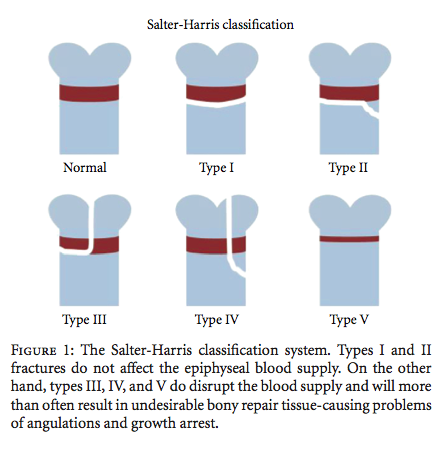This is a very quick study looking at the connection between growth plate fractures, and the bne bridges which can result from the bones healing after wards, which can often lead to limb lengthening issues like angular deformity. There are 5 types of growth plate fractures.
From Scientific Article entitled “Preclinical Studies on Mesenchymal Stem Cell-Based Therapy for Growth Plate Cartilage Injury Repair ” by Rosa Chung,1, 2 Bruce K. Foster,3 and Cory J. Xian1, 2 located HERE…
 “The Salter-Harris classification system has been used to distinguish the different types of growth plate injuries and the relationship between the characteristics of the fractures and their prognoses (Figure 1) [1, 8–10]. Current literature indicates that the most common type of growth plate fractures occurring in the distal tibiae of younger children is type II (around 40%), which in most cases has a reasonably good prognosis as the cells responsible for interstitial growth of the growth plate as well as the epiphyseal blood supply remain undisturbed [10–12]. Other types of fractures, types III, IV, and V, however, may/will all result in bony formation at the injured site [13]. It has been estimated that in up to 30% of all children with growth plate-related injuries, undesirable bony repair, and bone bridge at the injury site hinder normal growth of the developing long bone in the affected limb [14, 15], which results in significant orthopaedic problems such as limb length discrepancy and bone angulation deformity [15, 16]. “
“The Salter-Harris classification system has been used to distinguish the different types of growth plate injuries and the relationship between the characteristics of the fractures and their prognoses (Figure 1) [1, 8–10]. Current literature indicates that the most common type of growth plate fractures occurring in the distal tibiae of younger children is type II (around 40%), which in most cases has a reasonably good prognosis as the cells responsible for interstitial growth of the growth plate as well as the epiphyseal blood supply remain undisturbed [10–12]. Other types of fractures, types III, IV, and V, however, may/will all result in bony formation at the injured site [13]. It has been estimated that in up to 30% of all children with growth plate-related injuries, undesirable bony repair, and bone bridge at the injury site hinder normal growth of the developing long bone in the affected limb [14, 15], which results in significant orthopaedic problems such as limb length discrepancy and bone angulation deformity [15, 16]. “
From About.Com link HERE
Types of Growth Plate Fractures
By Jonathan Cluett, M.D., About.com Guide
Updated October 04, 2010

Pingback: Complete List Of Posts - |